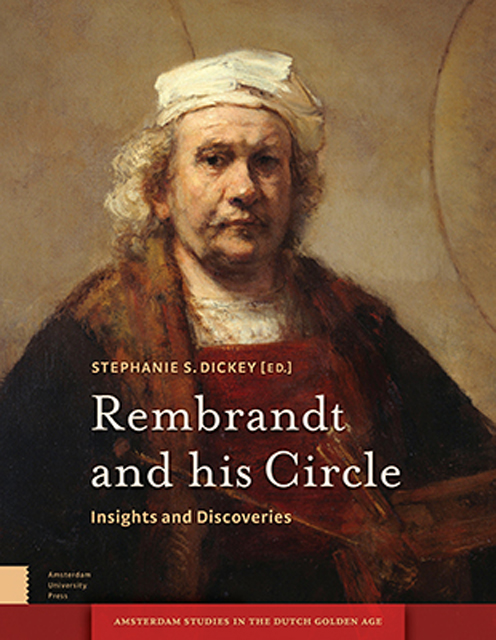Book contents
- Frontmatter
- Dedication
- Contents
- Acknowledgements
- Introduction
- 1 Rembrandt and Frans Hals Painting in the Workshop of Hendrick Uylenburgh
- 2 Rembrandt and the Germanic Style
- 3 Rembrandt and the Humanist Ideal of the Universal Painter
- 4 Curiosity and Desire: Rembrandt’s Collection as Historiographic Barometer
- 5 Painted Landscapes by Lievens and Rembrandt : The View from Seventeenth-Century Amsterdam Collections
- 6 Jan Lievens in Antwerp: Three Rediscovered Works
- 7 Gerrit Dou as a Pupil of Rembrandt
- 8 A New Painting by Jan van Noordt in Budapest
- 9 Rembrandt’s First Nude? The Recent Analysis of Susanna and the Elders from Rembrandt’s Workshop
- 10 Rembrandt’s Head of Christ: Some Technical Observations concerning Matters of Style
- 11 A Rediscovered Head of John the Baptist on a Platter from Rembrandt’s Studio
- 12 Rembrandt’s One Guilder Print: Value and Invention in ‘the most beautiful [print] that ever came from the burin of this Master’
- 13 Rembrandt, Ferdinand Bol, and Tobit: The Emergence of a Pathosträger
- 14 Biblical Iconography in the Graphic Work of Rembrandt’s Circle
- 15 Jan van Vliet and Rembrandt van Rijn: Their Collaboration Reassessed
- 16 Printmaking among Artists of the Rembrandt School
- 17 Chain Line Pattern Matching and Rembrandt’s Prints
- List of Illustrations
- Bibliography
- Index Nominum
4 - Curiosity and Desire: Rembrandt’s Collection as Historiographic Barometer
Published online by Cambridge University Press: 21 January 2023
- Frontmatter
- Dedication
- Contents
- Acknowledgements
- Introduction
- 1 Rembrandt and Frans Hals Painting in the Workshop of Hendrick Uylenburgh
- 2 Rembrandt and the Germanic Style
- 3 Rembrandt and the Humanist Ideal of the Universal Painter
- 4 Curiosity and Desire: Rembrandt’s Collection as Historiographic Barometer
- 5 Painted Landscapes by Lievens and Rembrandt : The View from Seventeenth-Century Amsterdam Collections
- 6 Jan Lievens in Antwerp: Three Rediscovered Works
- 7 Gerrit Dou as a Pupil of Rembrandt
- 8 A New Painting by Jan van Noordt in Budapest
- 9 Rembrandt’s First Nude? The Recent Analysis of Susanna and the Elders from Rembrandt’s Workshop
- 10 Rembrandt’s Head of Christ: Some Technical Observations concerning Matters of Style
- 11 A Rediscovered Head of John the Baptist on a Platter from Rembrandt’s Studio
- 12 Rembrandt’s One Guilder Print: Value and Invention in ‘the most beautiful [print] that ever came from the burin of this Master’
- 13 Rembrandt, Ferdinand Bol, and Tobit: The Emergence of a Pathosträger
- 14 Biblical Iconography in the Graphic Work of Rembrandt’s Circle
- 15 Jan van Vliet and Rembrandt van Rijn: Their Collaboration Reassessed
- 16 Printmaking among Artists of the Rembrandt School
- 17 Chain Line Pattern Matching and Rembrandt’s Prints
- List of Illustrations
- Bibliography
- Index Nominum
Summary
Abstract
Critics from the seventeenth century to the present have distorted Rembrandt's collection and collecting habit to their own varied ends. They have tended to seek (and prompt) overly simplified explanations that focus only on part of his remarkable and varied art collection, rather than on it in its entirety; indeed, typically, critics have been unable to see Rembrandt's collection as a whole. Early on, Rembrandt was accused of buying up bizarre stuff. More recently, his collecting has been reduced to a strategy for social climbing. Others have seen it as primarily functional, whether for his artistic practice or as dealer's stock. This essay examines how and why interpretations of Rembrandt's collection have shifted with the vicissitudes of his critical reputation.
Keywords: Rembrandt van Rijn, collecting, historiography, Rembrandthuis
Interpretations of Rembrandt's collection have shifted with the vicissitudes of his critical reputation. From shortly after his death to the present, much has been written about Rembrandt's collection, his motivations as a collector, and his extensive and inventive use of objects from his collection in the creation of his art. Yet, to a surprising extent, critics have interpreted and distorted Rembrandt's collection and collecting habit to their own ends. They have tended to seek, and prompt, overly simplified explanations that focus on only part of his varied collection; indeed, typically critics have been unable to see Rembrandt's collection as a whole, or even as a collection. Early critics, who knew Rembrandt's collection primarily through word of mouth, accused Rembrandt of buying up old clothes and bizarre or exotic objects. More recent critics, who rely on the inventory made on the occasion of Rembrandt's bankruptcy (fig. 4.1), have reduced his collection to a strategy for social climbing. Still others have seen it as primarily functional, whether for his artistic practice or as dealer's stock.
Historiographically speaking, Peter Paul Rubens is the artist-collector most comparable to Rembrandt, though he collected on a significantly grander scale. The difference between the two collections is mirrored in the contrast between the Rembrandthuis, impressive for an Amsterdam painter circa 1640, and the magnificent Rubenshuis with its triumphalarch, separate studio wing, and semi-circular sculpture gallery.
- Type
- Chapter
- Information
- Rembrandt and his CircleInsights and Discoveries, pp. 99 - 121Publisher: Amsterdam University PressPrint publication year: 2017



